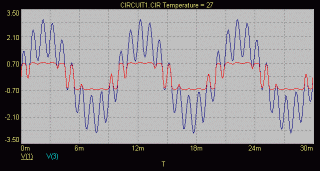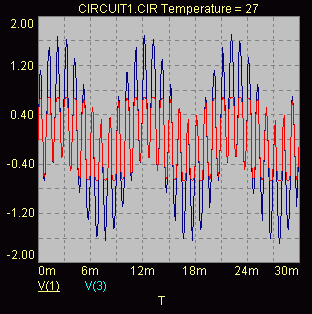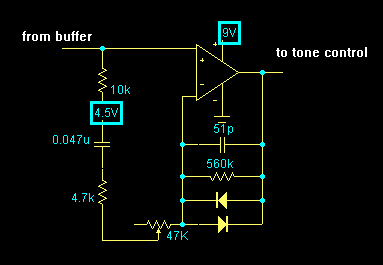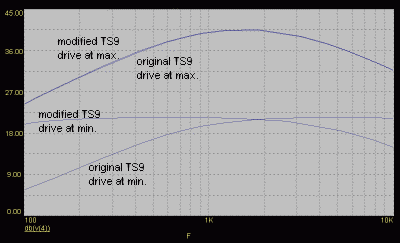

A mod to the tube screamer that will give you more bottom end when using it as a booster and still roll of the bass to prevent inter modulation when you're distorting the unit.
For a very good description of the basic principles of the ts see "The technology of the TS", by RG.
The reason why most distortion pedals roll of bass is to avoid inter modulation. OK, now what the hell is inter modulation? See the next picture:

The blue trace shows two pure tones added, one with 1 kHz and other with 100 Hz. Well, everybody knows that a typical guitar wave form is far from being a pure sine wave, but they make things a lot easier to explain. The red trace shows what happens when you apply clipping to the blue one. See how the amplitude of the 1 kHz tone almost zeroes where clipping occurs and is normal where the diodes aren't conducting? This amplitude modulation is related to the amplitude of the 100 Hz tone: when its amplitude rises, the 1 kHz tone disappears. So one component of the signal is amplitude modulating the other, hence the name "intermodulation". The effect in what you hear is a "beating", as something was out of tune. That's why chords sound horrible through a lot of distortion units. So what does the TS do to avoid this and not turning chords into trash? See the next picture:

Here, some high pass filtering was performed PRIOR to clipping, so the amplitude of the 100 Hz tone was decreased while the 1 kHz tone remained at the same level. There still happens some intermodulation, but the effect is much less pronounced (the 1 kHz tone never quite disappears, as before). Chords will sound much clearer, since one note is not interfering with another so much.
If this high pass filtering is so desirable, why would someone want not to have it? The answer is that a lot of people don't use the TS internal clipping, just using it as a booster to overdrive a tube amp. But if the amp is in overdrive, it would also show the intermodulation effect and make shit out of chords, right? Wrong. One aspect in which a classic tube amp is unlike a fuzz box is that you don't have a specific place where distortion occurs. It happens all along the whole amplifier, from the first stage to the speakers. Each stage will invert the signal and add a little (soft) asymmetric distortion, and after that the coupling between stages will remove the DC offset created by the asymmetry in distortion. This "progressive compression" will be much less prone to show intermodulation than a diode clipper, so an amp can handle a lot more bass, sounding "fatter" or "fuller" and still having good clarity at chords. So it would nice if we could have full bandwidth when the TS is not clipping (low drive) and progressively cut lows as we increase the drive, we would be able to morph between a fat booster and a clear overdrive in one box! Here's one way to do this (partial schematic):

Comparing it with the original:

We can see that at high gain the mod behaves just like the original, but at lower gains it will have much more bottom end.
If you want more gain, change the 560K resistor to 1M and use a 100 K pot.
Here is how it sounds. First, the riff is played through the TS with
drive on maximum, level adjusted so that the amp is not
overdriven. It's the typical TS sound, with a pronounced midrange
loved by some but the reason of many other's complaints. The gain
is a little higher because I'm using the 1M resistor. Next, drive
is set at minimum and level at maximum, so that the amp is
heavily abused. I use a master volume, so this is just the preamp
distorting. The amp settings were kept exactly the same, but the
sound is much... fatter!
Sound sample recorded with a Strat style guitar, two humbuckers
(bridge and neck in parallel). Amp is a 100W all-tube Fender
clone played through the reverb channel (you can hear the
springs). Cabinet is a closed back 4x12 miked with a Shure SM-57.
The power section is using EL34's and modified with a presence
control.
This page hosted by ![]() Get your own Free
Homepage
Get your own Free
Homepage